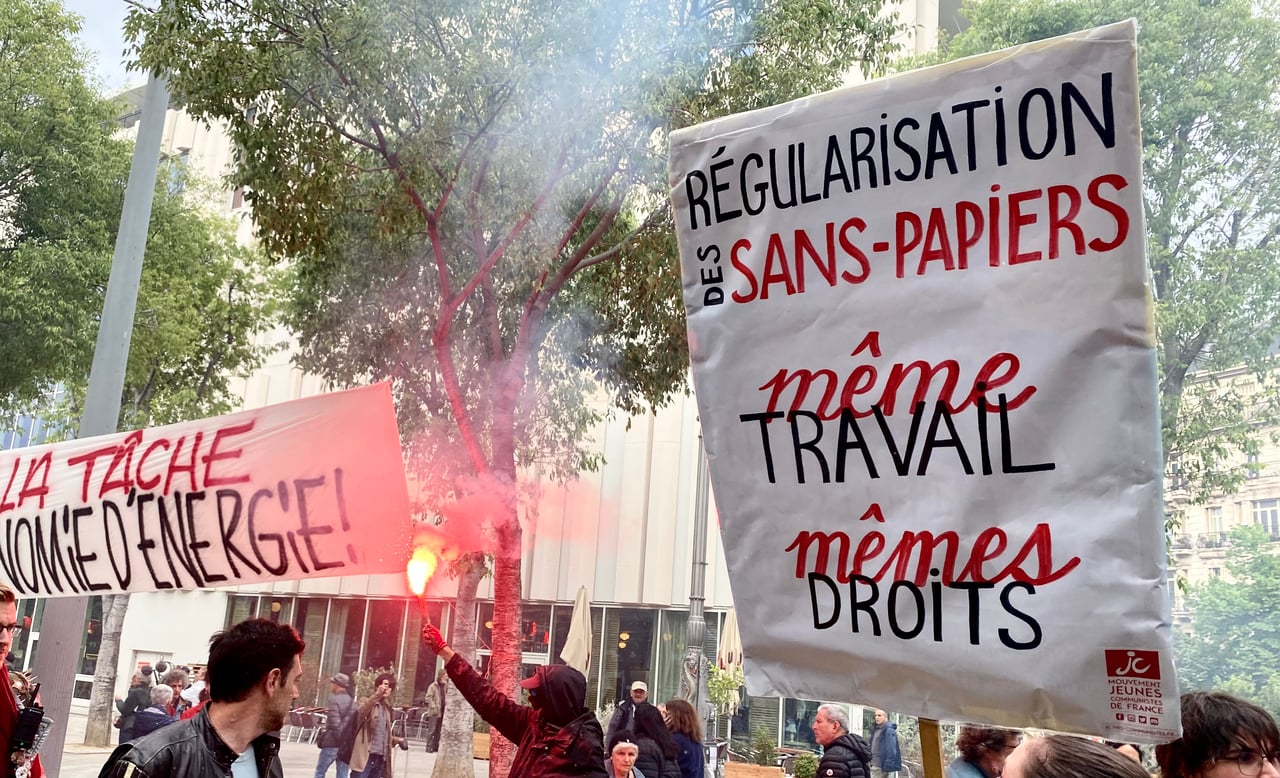MARSEILLE, France (CN) — On La Canebière in Marseille, a central boulevard cutting through the center of the city, Icona Pop blasted from a truck belonging to France’s biggest workers’ union, the Confédération générale du travail, or CGT. Hundreds, if not thousands, of people gathered under a light rain Wednesday — a rarity and a deterrent in a city that’s almost always sunny — to march for workers’ rights and cross-border solidarity on International Workers’ Day.
Though the May Day demonstrations are most commonly associated with workers’ rights, they more broadly advocate for equal rights and solidarity in topics that extend beyond France’s labor force.
Boris Plazzi, the confederal secretary in charge of European and international issues at the CGT, told Courthouse News that this year, one of the major international themes was supporting Ukrainians and Palestinians.
In Marseille, Palestinian flags and signs referencing Gaza were common throughout the march. There was also a cortege waving National Liberation Front of Kurdistan flags led by a banner reading “Against racism and imperialism.”

“It’s important to gather together in real life, to show up in numbers, to show that we’re all together,” Agnes, a demonstrator, told Courthouse News while sipping on a coffee, chatting with a friend on the sidelines of the march.
Domestic themes this year include worsening economic inequality, salaries that reflect inflation, and activism in general, according to Plazzi.
On one cardboard sign, “We want our salaries to reflect inflation” was scribbled in black Sharpie. A man chanted into a loudspeaker, “At the same time as justice, unity and solidarity.” Many CGT union members wore matching black hoodies with a red portrait of Che Guevara on the back.
The historical roots of International Workers Day actually tie to a country that doesn’t celebrate it on May 1: the United States. In 1884, American unions mobilized to demand an eight-hour workday, which only applied to federal employees at the time. On May 1, 1886, hundreds of thousands of people went on strike to push the movement forward.
Days later, things came to a head in Chicago, when violent clashes broke out between protesters and police, resulting in multiple deaths. In commemoration, the date was chosen to pay homage to the workers taking part in these demonstrations. This year in Marseille, a CGT union leader said the protesters of Chicago were “our comrades” into the megaphone ahead of the cortege.
“The CGT is an internationalist organization, which means we care about the living and working conditions of all workers around the world,” Plazzi said. “So, we are campaigning precisely for cooperation between workers, solidarity, unlike the neoliberal system which tends to want to put workers in opposition to each other wherever they are on the planet in order to promote profits.”
Though May Day demonstrations are intended to be peaceful, especially in recent years, videos of violent clashes between protesters and police have circled around social media. Last year, the marches were particularly charged with anger over President Emmanuel Macron’s unpopular retirement reforms.
May Day protests were largely peaceful throughout most of the 20th century, according to Pascal Cauchy, a history professor at the Institute of Political Studies at Sciences Po in Paris. But in the early 2000s, increasingly violent small groups started taking part. The black blocs — people who usually arrive in a group, conceal their identities, stir up riots and tend to clash with police — are in the headlines. The movement is often associated with communism and anarchy.
“Today, it’s very difficult to ensure civil peace during demonstrations because we know that there are these extremist movements that do not simply want to sow disorder, these are truly totalitarian movements in the sense that there is a real political project behind them,” Cauchy told Courthouse News.
Political parties are vying for media attention ahead of the European parliamentary elections June 6-9. Cauchy pointed out that the far-left France Insoumise movement has a history of provocation and may make moves to attract attention. He said that this year, the movement could try to sow violence in the protests, which risks detracting from the causes for which unions are advocating.
“It’s certain that for the unions, this is not good,” he said. “Inflation has greatly impacted part of the population and the poverty rate in France has reached records, as has the debt elsewhere.”
In Lyon, police deployed water cannons at protesters early in the afternoon. The Paris march took off from the central Place de la République about an hour later, heading toward the Place de la Nation. Between 15,000-30,000 people were expected to attend the march in the French capital.
Subscribe to Closing Arguments
Sign up for new weekly newsletter Closing Arguments to get the latest about ongoing trials, major litigation and hot cases and rulings in courthouses around the U.S. and the world.









